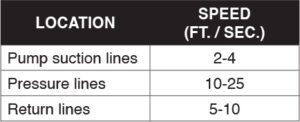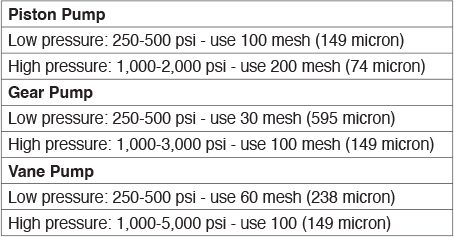6. What type of pump is being used? Is it a piston, gear, vane, or other type of pump? This would be important when installing a new or replacement suction strainer. Different pumps sometimes require more critical protection. The pump is the heart of the system. If it fails, the system fails. More directly said, if the pump dies, the system dies. Just like the human heart. If the heart quits or dies, the body does, too. Suction strainers have one purpose and one purpose only in a hydraulic system. That is to protect the pump. The chart that follows is a “general” guide to adequate protection for the pump in operation.
7. What type of filter is required? In-tank or in-line, when referring to suction straining? Replacement filter for an existing housing only? Replacement filter with a replacement cartridge in the housing? It is important to visually get this in your mind if you are unsure of what the requirement may be. Is the filter media, wire cloth, cellulose, synthetic? If so what is the synthetic material and has it been performing properly?
8. Will the system be operating continuously, intermittently, or infrequently? If a system is in operation continuously, possibly working 3 shifts per day, the filter selection may be one that can withstand the rigors of the constant operation. Is it a filter made with wire cloth media instead of cellulose or micro-glass media? If the filter will be used in a system that only operates once in a while, a less costly one may possibly be installed. The important decision to be made here is to install a filter that is best for the operation. The worst possible occurrence is machine break down because the filter installed couldn’t withstand the operation.

9. What is the system operating temperature? Hydraulic system standard operating temperature is “usually” around 100°F. If the temperature runs hotter than standard, it most certainly must be kept in check. Too hot a system can destroy seals and cause leakage, as well as, break down the fluid. Either a cooler should be installed or the proper seals, for example, Buna, Teflon, Viton, etc, must be used to be compatible with the operation.Hydraulic system standard operating temperature is “usually” around 100°F. If the temperature runs hotter than standard, it most certainly must be kept in check. Too hot a system can destroy seals and cause leakage, as well as, break down the fluid. Either a cooler should be installed or the proper seals, for example, Buna, Teflon, Viton, etc, must be used to be compatible with the operation.
 Cross Reference Guide
Cross Reference Guide
 Cross Reference Guide
Cross Reference Guide


